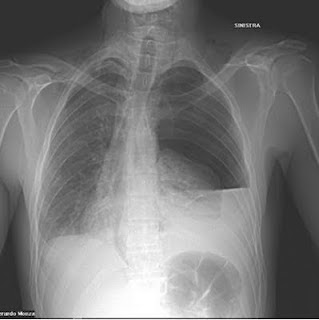 Pleural effusion is an abnormal accumulation of fluids in the pleural space Between the parietal and visceral pleura of the Lungs. Breathlessness, chest pain and non-productive cough are the most common symptoms associated with pleural effusion.
Pleural effusion is an abnormal accumulation of fluids in the pleural space Between the parietal and visceral pleura of the Lungs. Breathlessness, chest pain and non-productive cough are the most common symptoms associated with pleural effusion.Nursing Diagnosis and Interventions for Pleural effusion
Nursing Diagnosis: Ineffective airway clearance related to weakness and poor cough effort.
NOC:
• Demonstrate effective airway clearance and respiratory status evidenced by, gas exchange and ventilation are not dangerous:
- Having a patent airway
- Removing secretions effectively.
- Having a rhythm and respiratory frequency in the normal range.
- Having a pulmonary function within normal limits.
• Demonstrate adequate gas exchange, characterized by:
- Easy to breathe
- There is no anxiety, cyanosis and dyspnea.
- O2 saturation within normal limits
- Chest X-ray within the expected range.
NIC:
• Assess and document
- The effectiveness of the administration of oxygen and other treatments.
- The effectiveness of treatment.
- Trends in arterial blood gases.
• Auscultation of the anterior and posterior chest to find a decrease or absence of ventilation and the presence of noise barriers.
• Sucking airway
- Determine the need for oral suction / tracheal.
- Monitor the status of oxygen and hemodynamic status and cardiac rhythm before, during and after exploitation.
• Maintain adequacy of hydration to decrease viscosity of secretions.
• Explain the use of ancillary equipment properly, such as oxygen, suction equipment lenders.
• Inform the patient and family that smoking is an activity that is prohibited in the treatment room.
• Instruct the patient about the coughing and deep breathing techniques to facilitate the discharge of secretion.
• Negotiate with the respiratory therapist as needed.
• Give oxygen that has been humidified.
• Tell your doctor about the results of an abnormal blood gas analysis.
• Assist in the delivery of aerosol. Nebulizer and another lung treatment in accordance with institutional policies and protocols.
• Encourage physical activity to improve the movement of secretions.
• If the patient is unable to ambulate, the patient lies sleeping position changed every 2 hours.
• Inform the patient before beginning the procedure to reduce anxiety and increase self-control.
No comments:
Post a Comment